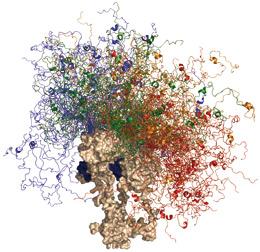
|
Call for Papers and Posters
Intrinsically Disordered Proteins: Analysis, Prediction, Simulation and Biology
Pacific Symposium on Biocomputing
January 3-7, 2012
Fairmont Orchid Resort
The Big Island of Hawaii, USA
|

|
Motivation
Intrinsically disordered proteins (IDPs) are an important newly recognized class of
proteins that rely on a lack of stable structures, both in vitro and in vivo, for function.
While the existence of such proteins was noticed as early as 1950s, their prevalence in
biology was not recognized until the late 1990s. Computation has played an important and
perhaps pivotal role in the development of the IDP field. It is now well recognized that
IDPs play fundamental roles in crucial biological functions and are extensively involved in
human diseases. The study of IDPs is rapidly evolving into a field of growing
prominence. Nonetheless, the dynamic and heterogeneous nature of IDPs has remained a
significant challenge, especially using experiments alone. This represents exciting
opportunities for computational approaches to make crucial contributions, from aspects
ranging from prediction and analysis to simulation. Clearly, important progress has
been made over the last ten years or so in computational investigations of IDPs.
Nonetheless, many open questions remain. There is a great demand for further development
of computational approaches that are more efficient and accurate, and at the same time,
can improve our understanding of biology from the molecular to the system level.
One of the main goals of this Session is thus to introduce and discuss:
1) important advances in all frontiers of computational "IDPology",
2) available computational capabilities in prediction, analysis and simulation of IDPs,
and more importantly, 3) outstanding challenges, further directions and key biological
questions to be addressed. Another goal is to promote communication and collaboration
between scientists working in different areas of IDP computation and
between experiment and computation.
Session Theme
We invite submissions on all aspects of computation in IDP research, and particularly
encourage those that enhance the ability to inform IDP function and regulation in biological
contexts. Some examples of important open questions relating to IDP computations are:
- How to further improve the accuracy of computational IDP predictions?
- How to integrate IDP predictions with the study and prediction of other
protein structural features. For example, how may IDP affect the post-modification
of a protein?
- How to better predict IDP sequence-to-function relationships? IDPs often rely on
local regions for phosphorylation, binding and other functions, making it extremely
challenging for reliable prediction.
- How to better compute and simulation different states of IDPs?
- What is the most effective means for integrating structural data from
simulation and experiment?
- Computational approaches to probe mechanistic aspects of coupled binding and folding
and to understand how IDP recognition is regulated.
- How to develop rational strategy for modulating IDP function in human diseases?
Note that all submitted papers should make clear their relevance for the
computational study of IDPs. If unsure whether your paper fits the session theme,
please contact one of the co-Chairs.
Session Co-Chairs
Submission Information
Please note that the submitted papers are reviewed and accepted on a competitive basis.
At least three reviewers will be assigned to each submitted manuscript.
Important Dates
- Paper submissions due: July 18, 2011
- Notification of paper acceptance: September 09, 2011
- Camera-ready final paper deadline: September 23, 2011
- Abstract deadline for non-reviewed posters: November 28, 2011
All deadlines are at midnight Pacific Standard Time.
Paper Format
Please see the PSB paper format template and instructions at
http://psb.stanford.edu/psb-online/psb-submit
The file formats we accept are: postscript (*.ps) and Adobe Acrobat (*.pdf)).
Attached files should be named with the last name of the first author
(e.g. altman.ps or altman.pdf). Hardcopy submissions or unprocessed TeX or LaTeX
files will be rejected without review.
Each paper must be accompanied by a cover letter. The cover letter must state
the following:
- The email address of the corresponding author.
- The specific PSB session that should review the paper or abstract.
- The submitted paper contains original, unpublished results, and is
not currently under consideration elsewhere.
- All co-authors concur with the contents of the paper.
Submitted papers are limited to twelve (12) pages in our publication format.
Please format your paper according to instructions found at
http://psb.stanford.edu/psb-online/psb-submit/.
If figures cannot be easily resized and placed precisely in the text, then it
should be clear that with appropriate modifications, the total manuscript
length would be within the page limit.
Contact Russ Altman for
additional information about paper submission requirements.



